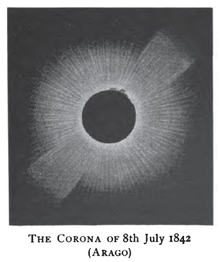Solar eclipse of July 8, 1842
| Solar eclipse of July 8, 1842 | |
|---|---|
 Map | |
| Type of eclipse | |
| Nature | Total |
| Gamma | 0.4727 |
| Magnitude | 1.0543 |
| Maximum eclipse | |
| Duration | 245 sec (4 m 5 s) |
| Coordinates | 50°06′N 83°36′E / 50.1°N 83.6°E |
| Max. width of band | 204 km (127 mi) |
| Times (UTC) | |
| Greatest eclipse | 7:06:27 |
| References | |
| Saros | 124 (45 of 73) |
| Catalog # (SE5000) | 9145 |
A total solar eclipse occurred on July 8, 1842. A solar eclipse occurs when the Moon passes between Earth and the Sun, thereby totally or partly obscuring the image of the Sun for a viewer on Earth. A total solar eclipse occurs when the Moon's apparent diameter is larger than the Sun's, blocking all direct sunlight, turning day into darkness. Totality occurs in a narrow path across Earth's surface, with the partial solar eclipse visible over a surrounding region thousands of kilometres wide.
Observations
 |
.jpg) Francis Baily |
Francis Baily observed the total solar eclipse from Italy, focusing his attention on the solar corona and prominences and identified them as part of the Sun's atmosphere. The solar eclipse effect now called Baily's beads named in honor of him after his correct explanation of the phenomenon in 1836.
Related eclipses
It is a part of solar Saros 124.
References
- NASA chart graphics
- Solar eclipse of July 8, 1842 in Russia
- Chronology of Discoveries about the Sun
- Total Eclipses of the Sun, By Mabel Loomis Todd, 1894, new and revised edition by David P. Todd, 1900.
| Wikimedia Commons has media related to Solar eclipse of 1842 July 8. |
